HIKING HAPPENINGS July 2010
Faux Falls – So Cool, So Refreshing
by Marcy Hafner
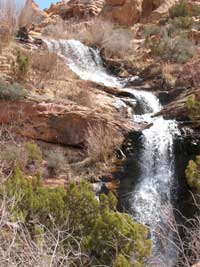 “Faux” is a French word that means “false” or “fake” and Faux Falls is a man-made surprise found smack dab in the middle of a dry, redrock environment that is filled with pinyon, juniper, blackbrush and yucca. On a hot summer day, however, this cool, supercharged waterfall feels real enough to me. “Faux” is a French word that means “false” or “fake” and Faux Falls is a man-made surprise found smack dab in the middle of a dry, redrock environment that is filled with pinyon, juniper, blackbrush and yucca. On a hot summer day, however, this cool, supercharged waterfall feels real enough to me.
The water that feeds the falls is diverted out of Mill Creek and channeled underneath Flat Pass through Sheley Tunnel. After the 645-foot course through the tunnel, it cascades down a series of rock ledges before plunging into a large pool. Then it’s the final dash down a lush stream channel to Ken’s Lake.
Around the beginning of the twentieth century Horace Sheley originally attempted but never finished this ambitious endeavor. For decades the project languished until the early 1970’s when a cycle of drought pressed the need for more water, and that sparked renewed interest in building the tunnel and reservoir. After years of planning, ground breaking began on October 4, 1979. Then on June 5, 1981, Ken’s Lake, which is named after former mayor and water conservancy district chairman Ken McDougald, was dedicated for irrigation purposes in upper Spanish Valley - long known as Poverty Flats because of its lack of water. The price tag was four million dollars and the 96-foot high earthen dam holds back an estimated 2,750 acre feet of water that allows for the cultivation of approximately 900 acres of land.
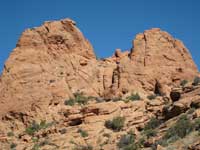 The Utah Division of Wildlife stocks the lake with brown and rainbow trout, which thrive in the maximum depth of 70 feet of water. Motorized craft are not allowed on the lake, and anglers, swimmers and boaters come here to enjoy a tranquil interlude. It’s also a great location to observe the migration of waterfowl, shorebirds and osprey. Along its mostly treeless edges, however, the lake’s rocky shore does get baking hot in the summer. That’s when I’m heading up the easy, partially shaded trail (less than a mile) for a riparian walk through the desert to Faux Falls, where shade and a steady mist create an outdoor evaporative cooler with a dramatic drop in temperature. The Utah Division of Wildlife stocks the lake with brown and rainbow trout, which thrive in the maximum depth of 70 feet of water. Motorized craft are not allowed on the lake, and anglers, swimmers and boaters come here to enjoy a tranquil interlude. It’s also a great location to observe the migration of waterfowl, shorebirds and osprey. Along its mostly treeless edges, however, the lake’s rocky shore does get baking hot in the summer. That’s when I’m heading up the easy, partially shaded trail (less than a mile) for a riparian walk through the desert to Faux Falls, where shade and a steady mist create an outdoor evaporative cooler with a dramatic drop in temperature.
To get to Faux Falls from Moab go south on Highway 191 approximately 7.5 miles and turn left at the sign for the Ken’s Lake-La Sal Loop Road. Continue half a mile to the stop sign at the tee and turn right on to the Spanish Valley Drive-La Sal Loop Road. Then drive about five miles and turn left on the Ken’s Lake-Flat Pass Road. Drive on by the turn in for Ken’s Lake to the entrance to the campground, where plenty of parking is available directly across the road from that entrance. If you are planning on staying overnight, the campground accommodates even the largest recreational vehicles and offers picnic tables, vault toilets, grills and trash receptacles, although drinking water is not available.
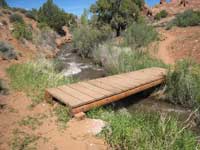 The trail begins directly across from campsite 25 and immediately drops down to a wooden bridge that crosses the gushing stream. At the signed intersection just beyond the bridge, go right, left takes you on to the Rock Loop Trail. The ridge line of Behind The Rocks presents a jagged edge profile on the western skyline, while South Mountain gives an alluring glimpse of alpine scenery before disappearing behind the buttress of hardnosed sandstone protrusions that backdrop the falls. The trail begins directly across from campsite 25 and immediately drops down to a wooden bridge that crosses the gushing stream. At the signed intersection just beyond the bridge, go right, left takes you on to the Rock Loop Trail. The ridge line of Behind The Rocks presents a jagged edge profile on the western skyline, while South Mountain gives an alluring glimpse of alpine scenery before disappearing behind the buttress of hardnosed sandstone protrusions that backdrop the falls.
At the next intersection, be sure to note the sign directing you right. Keep in mind this trail that parallels the creek the whole way contains its own water-loving habitat of cottonwoods, scouring rush, willows and water birch; there the scrub jay, black-throated gray warbler and Say’s phoebe find this lushness to their liking.
Faux Falls can be seen during most of the walk and then all of a sudden there is this huge roar of the falls straight ahead. Three ledgy steps to climb down and you are there where shouted conversation is the only way to be heard. But this is not the place to talk. It’s a place to listen and watch as the water cascades down a few hundred feet with so much energy, so much motion, so much power to the final freefall into a deep pool of frothy churning water.
The floating mist glistens and sparkles against red sandstone as the whirling droplets of water cover the rocks and super-saturate the ground. The shifting breeze constantly changes the direction of the mist and a hummingbird luxuriates as she bathes in this delightful zone of wetness. Then I hear the loud ringing song of a dipper – a bird of swiftly flowing western streams. I glance over and see him at the edge of a whirlpool - a chunky, slate gray bird with a large head and short neck and tail. His odd habit of constantly bobbing up and down with about sixty dips per minute always fascinates me. It also intrigues me that they choose a nest site along a stream just a few feet from the churning whirlpools so that their dome or ball-shaped nest structure is steadily doused with spray.
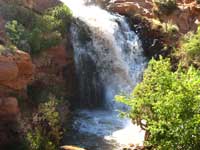 The dipper is the only North American aquatic songbird that catches all of its food of underwater insects and small fish by swimming or walking on the turbulent stream bottom. These unique birds have adapted to survive the frigid water with a low metabolic rate, extra oxygen carrying capacity in their blood and a thick coat of waterproof feathers. They even have a flap of skin that covers the nostrils while submerged, and their translucent eyelids permit underwater vision. The dipper is the only North American aquatic songbird that catches all of its food of underwater insects and small fish by swimming or walking on the turbulent stream bottom. These unique birds have adapted to survive the frigid water with a low metabolic rate, extra oxygen carrying capacity in their blood and a thick coat of waterproof feathers. They even have a flap of skin that covers the nostrils while submerged, and their translucent eyelids permit underwater vision.
I am mesmerized with this unexpected, out-of-place scene of tumbling water that bounces off the rock wall in a frenzied fury into the whirlpool below. Often I have this water park to myself and I enjoy the privacy of this quick escape from the summer heat staying as long as time allows for this welcome respite of cool relief.
|
Biological Soil Crust (aka)
Cryptos (krip’ tose):
The surface of
Moab’s desert is held
together by a thin skin of living organisms known as cryptobiotic
soil or cryptos. It has a lumpy black appearance, is very
fragile, and takes decades to heal when it has been damaged.
This soil is a critical part of the survival of the desert.
The cryptobiotic organisms help to stabilize the soil, hold
moisture, and provide protection for germination of the seeds
of other plants. Without it the dry areas of the west would
be much different. Although some disturbance is normal and
helps the soil to capture moisture, excessive disturbance
by hooves, bicycle tires and hiking boots has been shown
to destroy the cryptobiotic organisms and their contribution
to the soil. When you walk around Moab avoid crushing the
cryptos. Stay on trails, walk in washes, hop from stone to
stone. Whatever it takes, don’t crunch the cryptos
unless you absolutely have to! |
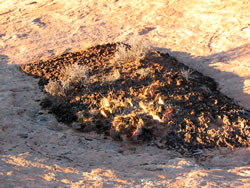
Cryptobiotic soil garden
|
|
|